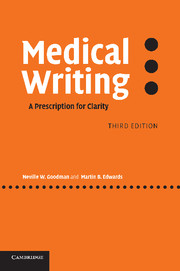Book contents
- Frontmatter
- Contents
- Preface to the first edition
- Preface to the third edition
- Acknowledgements
- PART I PROBLEM: THE ILLNESS
- PART II SOLUTION: SYMPTOMATIC RELIEF
- 3 Guidelines to clearer writing
- 4 Is there a better word?
- 5 Superfluous words
- 6 Imprecise words and phrases
- 7 Superfluous phrases
- 8 Trouble with short words
- 9 Use of the passive voice
- 10 Consistency: number and tenses
- 11 Circumlocution, metaphor and cliché
- 12 Word order and pronouns
- 13 Punctuation
- 14 Constructing sentences
- 15 Drawing clear graphs
- PART III PRACTICE: RECUPERATION
- Appendix: examples to rewrite
- References and further reading
- Index
8 - Trouble with short words
Published online by Cambridge University Press: 23 November 2009
- Frontmatter
- Contents
- Preface to the first edition
- Preface to the third edition
- Acknowledgements
- PART I PROBLEM: THE ILLNESS
- PART II SOLUTION: SYMPTOMATIC RELIEF
- 3 Guidelines to clearer writing
- 4 Is there a better word?
- 5 Superfluous words
- 6 Imprecise words and phrases
- 7 Superfluous phrases
- 8 Trouble with short words
- 9 Use of the passive voice
- 10 Consistency: number and tenses
- 11 Circumlocution, metaphor and cliché
- 12 Word order and pronouns
- 13 Punctuation
- 14 Constructing sentences
- 15 Drawing clear graphs
- PART III PRACTICE: RECUPERATION
- Appendix: examples to rewrite
- References and further reading
- Index
Summary
Many short words can act as different parts of speech: prepositions, conjunctions, adverbs or pronouns (see p. 29). Instead of being grouped grammatically, the words are grouped here under more general headings to make it easier to find and correct mistakes.
Following a verb
Certain verbs are followed by particular prepositions. Some verbs alter their meanings with the preposition; compare is the verb most misused in this way. It can be helpful when trying to decide which preposition is correct to consider the nouns formed from the verbs (and vice versa). For instance, which is correct of different from, different to and different than? Most people using to differ say it differs from; thus different is usually followed by from not to. (Different than is American usage.)
COMPARE to or with?
Compare to means liken to. The example usually quoted is from Shakespeare's sonnet: ‘Shall I compare thee to a summer's day?’ A comparison between one thing and another (or a number of others) is always one with another. Compare with also allows the consideration of both similarities and differences.
…lower after epidural compared to intraperitoneal…
This is not a great drawback when compared to the use of musculocutaneous flaps…
Both should be compared with (but see use of than below).
Drawback is not a good choice of word, particularly when discussing flaps. There is the joke:
‘What is the biggest drawback in the jungle?’
‘An elephant's foreskin.’
Disadvantage is the required word.
Transfused patients had a poorer prognosis compared to non-transfused patients…
- Type
- Chapter
- Information
- Medical WritingA Prescription for Clarity, pp. 123 - 138Publisher: Cambridge University PressPrint publication year: 2006



